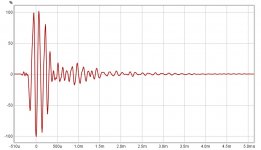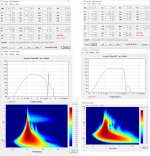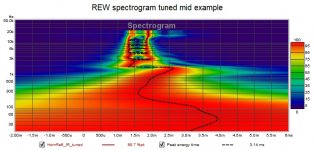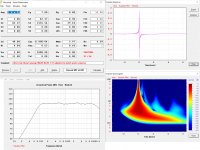Forum member mbrennwa has made handy scripts for signal manipulation in matlab / gnu octave as well, if more granular approach is needed 🙂 GitHub - mbrennwa/mataa
Welll HOLM is being a royal pain and crashing every time I try to import the impulse files. I've tired several different formats with no luck. Will keep truing.
REW does allow me to change the impulse window, but it seems to have no effect of waterfall or spectragram plots. 🙁 I did edit the impulse by hand and import it, that seems to work, but is pretty darn time consuming.
Need to bang on it with a different hammer. Will report back
REW does allow me to change the impulse window, but it seems to have no effect of waterfall or spectragram plots. 🙁 I did edit the impulse by hand and import it, that seems to work, but is pretty darn time consuming.
Need to bang on it with a different hammer. Will report back
Thank you Pano, sorry to hear that, that's been my experience too.
I wish I could figure out a microphone gate that opens after a set time from impulse trigger.
I think it can be done with q-sys if I learn some control scripting....if/when I ever get done wrestling with latest synergy project Lol
Good luck, and thx again
I wish I could figure out a microphone gate that opens after a set time from impulse trigger.
I think it can be done with q-sys if I learn some control scripting....if/when I ever get done wrestling with latest synergy project Lol
Good luck, and thx again
Forum member mbrennwa has made handy scripts for signal manipulation in matlab / gnu octave as well, if more granular approach is needed 🙂 GitHub - mbrennwa/mataa
Thx tmuikku, I have to admit i'm really weak with simulations and computer analysis 😱
But i'm good at dreaming up ways to make garbage measurements 😀
In REW you can set an IR window then export the IR corresponding to your measurement. Then a window pops up and you can choose to export with or without the window applied. Choose with and then re-import.
I did finally find a format that won't crash HOLM and imported the impulses. Thing is, I don't know what I'm seeing. With that horn, a mouth reflection should take about 56 ms round trip, but I don't see anything remarkable in the impulse at that point. Have you?
Maybe it would be better to use a mic at the mouth of the horn. Then your reflection would need to reflect twice before you see it. Off the mouth edge, back to the throat then out again. That's mostly what you care about - the sound coming out of the horn mouth, not what's happening at the driver diaphragm.
Maybe it would be better to use a mic at the mouth of the horn. Then your reflection would need to reflect twice before you see it. Off the mouth edge, back to the throat then out again. That's mostly what you care about - the sound coming out of the horn mouth, not what's happening at the driver diaphragm.
That's the sort of thing that would help.Then a window pops up and you can choose to export with or without the window applied.

On going thx guys...
Jack, i see how it works, now i just have to figure out what window to apply...and what
Window Ref Time...must study REW manual.
Pano, I'm thinking you must have typoed on the round trip reflection time.?
The xt1464 is 10" deep, straight line from flange to end of mouth, which I get to be about 1.5ms round trip.?
In trying to figure out what I should be looking at...
Attached is one of the impulses.
I know I have a single sample pulse...that's about it really haha..
Ok, I figure the first 4 tall positive peaks (and their negative oscillations) might all be due to the impulse. Measured distance between the VHF and HF sections in the 4594HE is about 0.08ms, which kinda matches high peak to low peak timing through those oscillations.
I'm thinking reverb between the sections...Pure spitballing …
Anyway, that set of large oscillations is over at about 0.33ms....and I'm thinking the following junk are reflections that end a little past 1.5ms.
Am i even on the right track....?
Windowing suggestions? I'd like to get the big oscillations out as a start, but have no idea yet what REW is telling with windowing with a few quick pokes at it..
Jack, i see how it works, now i just have to figure out what window to apply...and what
Window Ref Time...must study REW manual.
Pano, I'm thinking you must have typoed on the round trip reflection time.?
The xt1464 is 10" deep, straight line from flange to end of mouth, which I get to be about 1.5ms round trip.?
In trying to figure out what I should be looking at...
Attached is one of the impulses.
I know I have a single sample pulse...that's about it really haha..
Ok, I figure the first 4 tall positive peaks (and their negative oscillations) might all be due to the impulse. Measured distance between the VHF and HF sections in the 4594HE is about 0.08ms, which kinda matches high peak to low peak timing through those oscillations.
I'm thinking reverb between the sections...Pure spitballing …
Anyway, that set of large oscillations is over at about 0.33ms....and I'm thinking the following junk are reflections that end a little past 1.5ms.
Am i even on the right track....?
Windowing suggestions? I'd like to get the big oscillations out as a start, but have no idea yet what REW is telling with windowing with a few quick pokes at it..
Attachments
Yep, a "thought typo". I was thinking of the distance to the mouth and back, but then wrote about time. About 56 cm round trip, or 1.6 ms more or less.
FWIW, that impulse is a mess. Maybe that comes from recording with one part of the driver as a mic. If I were looking for reflections at the mouth, I'd put a mic at the horn mouth, maybe a little in front of it. Take a measurement with the horn alone than change the mouth somehow and take another measurement. Compare the two. Use a swept sine measurement.
You could extend the mouth, use a roll-over, a soft termination of whatever would change how sound reflects back from the termination. If you see something different, you're on the right track.
FWIW, that impulse is a mess. Maybe that comes from recording with one part of the driver as a mic. If I were looking for reflections at the mouth, I'd put a mic at the horn mouth, maybe a little in front of it. Take a measurement with the horn alone than change the mouth somehow and take another measurement. Compare the two. Use a swept sine measurement.
You could extend the mouth, use a roll-over, a soft termination of whatever would change how sound reflects back from the termination. If you see something different, you're on the right track.
figuring out what to do and then the detail of how to do it is the hard part.
Ideally you would take an IR with a prominent reflection in it. Then it would be clear what to do. Extract the samples of the reflection from the IR and using them to construct the IR of a FIR that can be put into the signal chain to pre-distort the signal so that that reflection is cancelled.
If you take your measurement at the mouth of the horn, the reflections appear at the round trip time from the original impulse, the same delay at which they would arrive at one's ear. So theoretically, just take that IR, zero out all the samples except those of the reflection, complement the reflection samples and use the resulting IR as a pre-distortion filter.
When you convolve (which is a summation process) the original sequence which we can describe as "signal plus reflection" with the modified IR which is or should be "-reflection" the sum is "signal"
Test that in REW by multiplying in the frequency domain in the All SPL tab
I'm sure its not that easy and I don't understand the data formats but it might be worth a hack or two.
Ideally you would take an IR with a prominent reflection in it. Then it would be clear what to do. Extract the samples of the reflection from the IR and using them to construct the IR of a FIR that can be put into the signal chain to pre-distort the signal so that that reflection is cancelled.
If you take your measurement at the mouth of the horn, the reflections appear at the round trip time from the original impulse, the same delay at which they would arrive at one's ear. So theoretically, just take that IR, zero out all the samples except those of the reflection, complement the reflection samples and use the resulting IR as a pre-distortion filter.
When you convolve (which is a summation process) the original sequence which we can describe as "signal plus reflection" with the modified IR which is or should be "-reflection" the sum is "signal"
Test that in REW by multiplying in the frequency domain in the All SPL tab
I'm sure its not that easy and I don't understand the data formats but it might be worth a hack or two.
The problem may lie in separating the initial impulse from the reflections. If measured at the horn mouth the reflection path will be somewhere around 78 cm, which corresponds to a frequency of 440 Hz. That might be far enough away from the horn response to see it.
That is definitely the problem, which is why I suggested using a measurement with a prominent reflection. The most prominent one would be that of the mid driver in an MEH coming back from the throat. And mouth reflections from a rectangular wooden conical horn would likely be more prominent than in something like the XT1464 and its ilk.
and the other problem is that there are likely multiple reflections and the reflections can be reflected, at least if not cancelled.
and the other problem is that there are likely multiple reflections and the reflections can be reflected, at least if not cancelled.
The only thing I could see from the impulses what a ringing that seemed to keep going circa 6.3K.
Agree that setting up a distinct reflection to see what it looks like on the impulse would be very helpful.
Agree that setting up a distinct reflection to see what it looks like on the impulse would be very helpful.
I've had no look finding a delayed copy of the initial impulse in any of the many old measurements I looked, including those of my synergy mids.
Maybe we need to go back to Mark's measurements at the throat to see what is undeniably a reflection so long as we look far enough out in time.
Maybe we need to go back to Mark's measurements at the throat to see what is undeniably a reflection so long as we look far enough out in time.
I revisited the HR sim of my synergy mids. Clearly saw ghost IRs in the impulse spectrogram. Exported the IR from HR and brought it into REW for a closer look. All I saw out at the delays corresponding to those ghost IRs were some small bumps. Not very encouraging unless to indicate that reflections aren't a big problem. Time to reread the Gunness paper and patent
but the bandpass chamber of those mids had been carefully tuned and equalized to optimize the response. Mistuning the chamber to maximize the null, I get clearer picture in impulse spectrogram and very different IR.
So reflections are visible in these impulse IRs from HR; but not clear how to extract the reflections from them. The simple process I had in mind earlier today fails in the face of even simulated data, never mind measurements.😱
So reflections are visible in these impulse IRs from HR; but not clear how to extract the reflections from them. The simple process I had in mind earlier today fails in the face of even simulated data, never mind measurements.😱
Attachments
Nice continuation guys. Sorry to disappear,.... incoming kids for holidays...
Yep, I think i do need to explore what's going on at horn mouth, in conjunction with trying to measure back at the throat.
Also putting a mic right at the throat, playing signal into the horn like it's a big ear.....like what i think you're talking about Jack.
And I really would like to know what makes all the initial oscillations using one section of the CD as a mic.
Yeah Pano, biggest mess of an impulse I think I ever saw 😱
Guess I should try the dcx464 too (only tow CDs I have)
Yep, I think i do need to explore what's going on at horn mouth, in conjunction with trying to measure back at the throat.
Also putting a mic right at the throat, playing signal into the horn like it's a big ear.....like what i think you're talking about Jack.
And I really would like to know what makes all the initial oscillations using one section of the CD as a mic.
Yeah Pano, biggest mess of an impulse I think I ever saw 😱
Guess I should try the dcx464 too (only tow CDs I have)
Having some fun with simulations; more comfortable (and controllable) than doing measurements and gives us an idea what we are up against.
I imported the simulations IR into REW to see if I could reproduce the same spectrogram there. This is as close as I could get and shows a distinct reflection in the HF and that the reflection is so close (synergy mids reflecting off throat) that both primary and reflection IRs are on top of each other
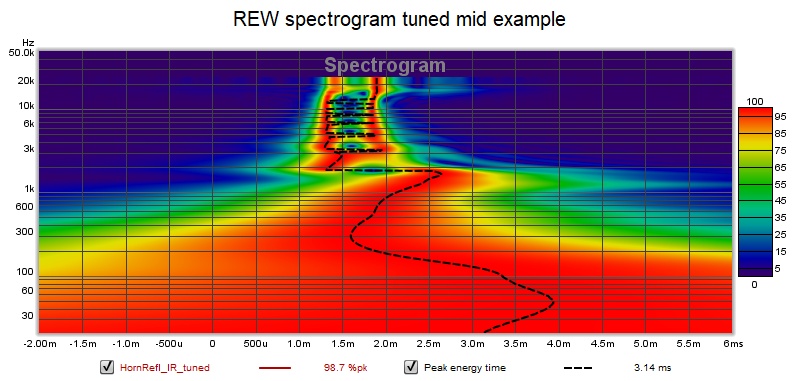
So that was the Synergy mid. The mouth reflection doesn't show up there so I modified the sim with a driver at the throat and no mid. This is the same mid driver but EQed flat because I'm only interested in the horn characteristics.
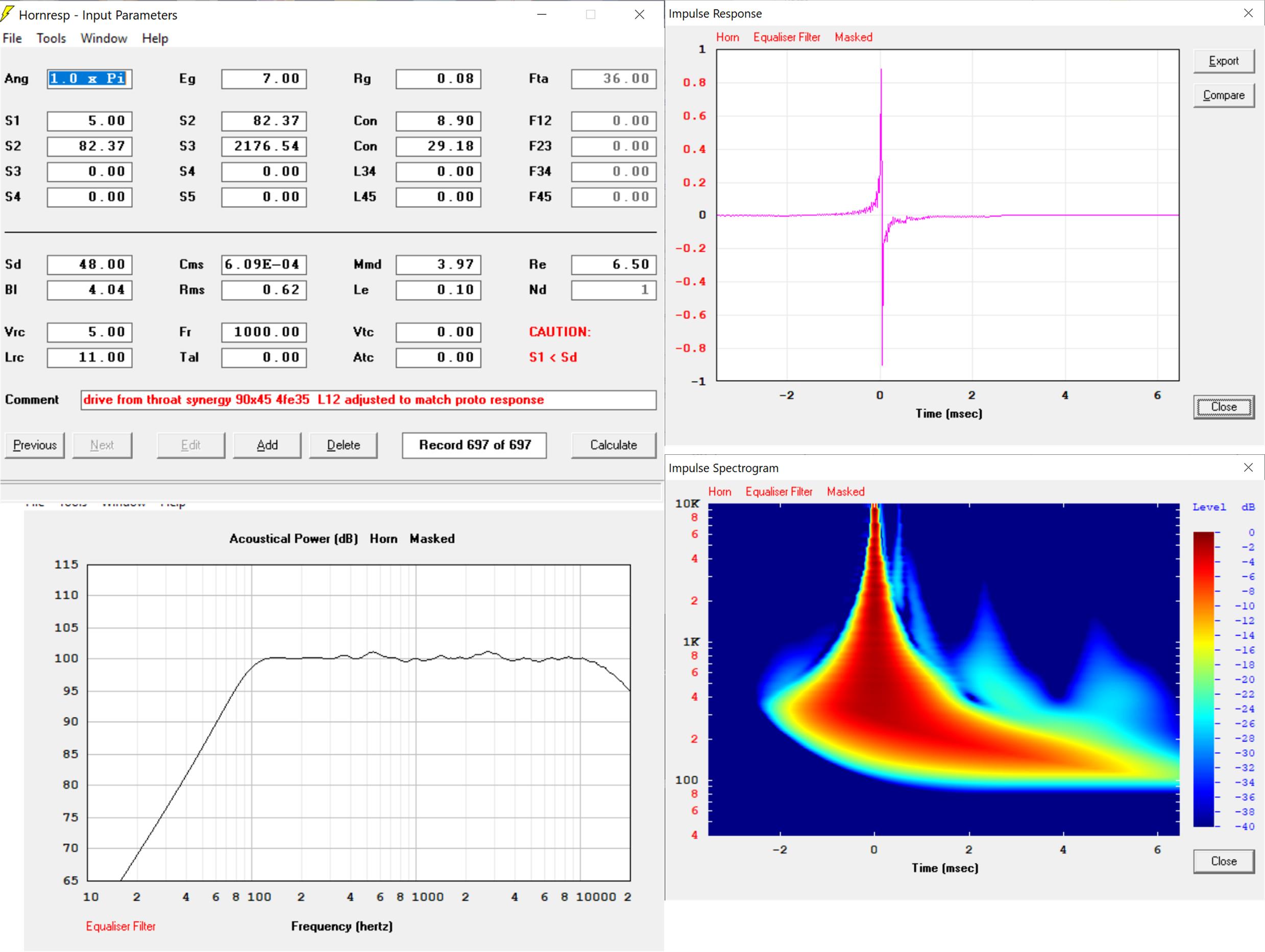
Distinct reflections again appear with the earliest one being about 26 db down. It turns out this is too faint to show up in a REW spectrogram so I'm not showing the REW.
Again, as we discussed earlier, the trick will be separating the reflection impulse from the primary impulse in order to do cancellation. You can see that the visible reflections are at higher frequencies than the primary where the two overlap in time, so some kind of time+frequency discrimination process might work....
I imported the simulations IR into REW to see if I could reproduce the same spectrogram there. This is as close as I could get and shows a distinct reflection in the HF and that the reflection is so close (synergy mids reflecting off throat) that both primary and reflection IRs are on top of each other
So that was the Synergy mid. The mouth reflection doesn't show up there so I modified the sim with a driver at the throat and no mid. This is the same mid driver but EQed flat because I'm only interested in the horn characteristics.
Distinct reflections again appear with the earliest one being about 26 db down. It turns out this is too faint to show up in a REW spectrogram so I'm not showing the REW.
Again, as we discussed earlier, the trick will be separating the reflection impulse from the primary impulse in order to do cancellation. You can see that the visible reflections are at higher frequencies than the primary where the two overlap in time, so some kind of time+frequency discrimination process might work....
Attachments
- Home
- Loudspeakers
- Multi-Way
- Measuring horn reflections back into the throat
